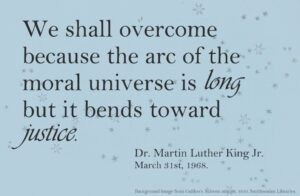
Marty Levine
June 4, 2025
For four weeks, while we traveled across Southeast Asia, I was able to put aside some of the political turmoil in our country. But, while we were gone, sadly, the turmoil has not faded away. The Trump administration continues on in its quest to reshape our country.
This moment reminds me of 1968, when I was a Columbia University graduate student. We saw our university as a microcosm of what was wrong with our nation. It had ties to the military/industrial complex that was behind our nation’s disastrous invasion of Vietnam. Its desire to build a new gym in Harlem was evidence of its inherent racism. We believed that if we could push Columbia to make systemic changes, we would be demonstrating what was possible for our nation. So, we protested, we struck, we occupied Hamilton Hall, and we shut down Columbia University for days.
When the university’s leadership finally agreed to negotiate with us, I was faced with a challenge. How much should we compromise? What level of concession by the university would be enough for us to relent and allow campus life to return to normal?
I was engaged in a debate with myself and my fellow strikers. For some, and ultimately me, there was a point of compromise. We had faith that the system we were challenging could be pushed and could evolve, albeit slowly. We believed that the changes we achieved that day were only the first step in a process of change that would now be ongoing.
For some of my colleagues, this was nonsense. They strongly believed that the system was so broken that it could not be reformed. They felt what was needed was total destruction and the rebuilding of a new university that would be created to reflect our values and beliefs.
Reform or build anew was the debate.
Now, years later, I find myself still in the same debate.
The changes needed today are broader than just reforming one university. The systems that seem broken are those that underpin our entire system of governance and distribution of wealth.
The question remains whether they can be fixed by a gradual process of reform? Or are they inherently so broken, or built with so much bias, that they cannot be fixed and must be replaced?
Dr. Martin Luther King spoke of his faith that slow and steady progress was possible, but was he correct when he told us the universe bends toward justice?

If he was, then all we need to do is keep on marching, keep on phone calling, keep on advocating.
Donald Trump and his merry band of MAGA faithful are clear that they think that they can shape that arc by taking it into their own hands and bending it. For them, destroying and rebuilding is the game plan. In less than six months since they were reinstalled in control of our government, they have gone about it with speed and force. They seem to have learned from Trump’s first term that working within the existing systems of government would bring change incrementally, not quickly nor dramatically. They fueled their desire to reshape the nation and to empower white, male, Christian people of wealth with the revolutionary models put forward by the tech entrepreneurial “wisdom” of the necessity of breaking things.

They recognized that many of my fellow citizens have viewed our government as out of touch and ineffective. Whatever slow improvements in systems that should be making people’s lives better have not been enough to demonstrate that our government works. For those who support the political agenda that the MAGA movement espouses, giving Trump another chance had no risk and much promise. That was no surprise.
What was surprising and critical in that election was the disaffection of voters from the Democratic side of the spectrum. Kamala Harris received a total of 76,917,038, 4,366,418 fewer votes than Joe Biden received four years earlier; that’s more than a 5% decline in support. And, although I cannot quantify this, I believe that the loss of voters was matched by a loss of enthusiasm about a candidate and a party that was promising to just keep doing what they had been doing: working for small and incremental changes when that was possible. In the face of a movement that recognized that we had a broken system that needed radical fixing, the message of slow, steady progress fell flat because it seemed to have already proved to be a failure.
Rather than push broken systems out of the way and replace them with new approaches that can remedy the problems we face, Democrats when in power and also when as the loyal opposition, have chosen incremental change and told their more radical supporters that big change is not possible. In the process, over decades, the middle of the political spectrum has been pushed far to the right.. What was middle of the political road thirty years ago is now seen as extreme and radical, as “socialist” and “communist”.
In a nation where access to health care is a decades-old problem, when Democrats have been in power, they have settled for important but modest actions. The result has been that we have never created a national plan to ensure that all have access to care. We have created a patchwork of programs that try to get as many into the system as possible. As a result, it has left in place many of the structural elements that were causing the problem in the first place. Challenging the interests of the large corporate insurers that profit greatly from our current approach to medical care, and challenging the companies that dominate the pharmaceutical industry, and their entrenched interests, was more than Democrats in power were willing to do.
Democrats accepted that ensuring health care for all was not possible because they would not fight for it. They would not risk alienating people who didn’t like one or more parts of the change that would be needed. They assumed that the more progressive elements of their “base” would always support them, so there was no need to challenge those who were on the right. And in not delivering a better system, they lost anyway.
This political cowardice looks the same when we examine fixing the environmental crisis we face or ensuring everyone can have an adequate annual income to provide for life’s necessities. It looks the same when we consider access to abortion or protections for those who have been historically othered. It even looks the same when we examine who we have protected, or something so basic as the right to vote.
That was my lesson learned from 2024.
And now we will face the same challenge in 2026. What kind of candidates do we want to be running?
Two local races are shaping out in my community that pose an interesting question of who will bring a chance for the real change we need.
One is for a now-open seat in the US Congress, and the other will fill a seat in the Illinois State Senate. Both will see established politicians being challenged by young, relatively unknown but very progressive newcomers. All of the established politicians looking to move up the political ladder will present themselves as “liberal”, even as “progressive.” But each seems committed to the old-style politics of getting along, making waves only when it fits into the mainstream of their party, and working for small changes along the way. The outsiders will share many positions with these insiders but will pledge to govern differently, to stand by their convictions and fight battles that are right even if they seem unwinnable.
I know I will hear much guidance to support the practical, to elect people with experience and existing relationships, even when their track record tells us they will keep us taking baby steps forward if they take any steps at all. I will hear guidance that it is too risky to try to elect outsiders because they are promising a new spirit of change and because they will not have the constraints of history holding them back.
If there is a lesson to be learned from Donald Trump and MAGA, it is “go big or go home.” When big changes are needed, don’t shy away from them; embrace them. When there are entrenched forces that are holding these changes back, confront them directly and very publicly.
Looking at the state of our nation today. What do we really have to lose by fighting for real change? If I am right than we can win and make this country the land it says it is, one where all are created equally and where we ensure true equality and equity. If I am wrong will things really look much worse than they do today?
I think not.
